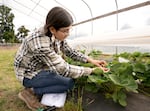On a warm June afternoon last year, Oregon State University’s North Willamette Research and Extension Center was bustling. The 160-acre agriculture research station outside Aurora, Oregon, grows everything from Christmas trees to kiwi fruit, and has upwards of 75 different field trials happening at any one time.
Scientists, researchers and farmers were gathered for Strawberry Field Day, getting updates on the latest research on strawberry production in the Pacific Northwest. NWREC began in 1957, but OSU’s research on strawberries goes back even further.
Since 1917, OSU has worked with the USDA Agricultural Research Service in a one-of-a-kind cooperative berry breeding program to develop varieties specifically made for the Pacific Northwest. The iconic Hood strawberry came from the collaboration in 1965, and the beloved Tillamook variety was released in 2004. Mary’s Peak, Sweet Sunrise, Totum and many more were all results of the partnership.

Oregon State University masters student Joussy Hidrobo tending to a strawberry test plot at the North Willamette Research and Extension Center in Aurora, Ore., on June 8, 2022.
Arya Surowidjojo / OPB
Strawberries have a long history in Oregon, both as part of our agricultural landscape and also as part of our state’s story. From traveling on the Oregon Trail, to new varieties developed to combat disease, to a century old celebration with enough strawberry shortcake to feed a city … Oregon is serious about its strawberries.
A sweet science
Strawberry varieties can take years to perfect, says Ted Mackey, a biological science technician in OSU’s breeding program.
“It could take 10, 15 years,” Mackey said. “Maybe if you’re lucky, seven years to go from cross to the market to actually naming a strawberry.”

Ted Mackey works for the U.S. Department of Agriculture as a biological science technician in the berry crops breeding program. He was one of the speakers at the North Willamette Research and Extension Center's Strawberry Field Day on June 8, 2022.
Stephani Gordon / OPB
Plant breeding goes back centuries, and starts by crossing two plants with desirable traits that the other does not have — strawberry X has intense flavor but grows a small fruit, while strawberry Y has large fruit without much flavor. The seeds from those crosses have the same parent, but they’re slightly different genetically.
“It’s like having a family,” he said. “Let’s say, you plant out 100 seeds — brothers and sisters — same parents, but slightly different.”
Out of the 100 strawberry plants that grow from that initial cross, Mackey said breeders may only pick one as a standout to propagate for the following year. After that, the new variety would go to the research center to be planted and studied in field trials. But even if the strawberry plant has all the traits they bred for and is growing well at the agriculture research station, there’s still more before it can be released as a new variety.

New strawberry varieties grown at the North Willamette Research and Extension Center are ready to be taste-tested during OSU's Strawberry Field Day on June 8, 2022.
Crystal Ligori / OPB
“We also try to get it into a grower’s hands so that they can grow it in their fields under their conditions and see how it does for them,” said Mackey. “Because it may look good here, but they grow it out and they say, ‘This is terrible, we don’t want that’ or they might say, ‘Hey, this is great.’” That would be year seven or eight.”
It’s a long process that Mackey has been a part of for nearly 30 years. Early in his career, he worked with legendary research geneticist and USDA berry breeder Chad Finn, gathering wild strawberries in order to try to diversify the genetic pool.
“We went on a collection tour [and] collected wild plant material and made crosses to get more of those genes back into the standard varieties,” he said. “The goal was to reinvent the strawberry.”
Outside of the Pacific Northwest, Mackey said, strawberries just don’t taste the same.
“If I give somebody one of our Oregon berries who’s never had one, often they’re just like, ‘Oh my God, I had no idea that this was possible.’”
A strawberry worth celebrating
Strawberries have grown wild across the state for millennia, but modern strawberry varieties made their way here via the Oregon Trail.
In the 1840s, Henderson Luelling uprooted his Iowa fruit nursery to head out West, outfitting two of his wagons as traveling nurseries filled with fruit trees, shrubs and, of course, strawberry plants.
The strawberries thrived in Oregon’s mild climate, and soon the Willamette Valley became a hub for strawberry production in the West, something Joel C. Mayer and A. M. Reeves thought was worth celebrating.
The two Lebanon businessmen hatched an idea in 1909 to create the Lebanon Strawberry Festival to celebrate the strawberry harvest season.
It’s since become the second longest running annual festival in the state, started just two years after the Portland Rose Festival. There’s a parade, a carnival, and even festival ambassadors aptly named “Strawberrians.” At the center of it all is the World’s Largest Strawberry Shortcake.

The centerpiece of the Lebanon Strawberry Festival is the "World's Largest Strawberry Shortcake," seen here in 1949.
Courtesy of the Lebanon Strawberry Festival
“Originally, the strawberry shortcake was created to celebrate the strawberry harvest,” said Cindy Ongers, the Strawberry Festival shortcake chair.
It was a tradition started in 1931, but the “World’s Largest” title was finally solidified in 1975, with a 5,700 pound shortcake. It served more than 16,000 people, which at the time was double the town’s population. Nowadays, the cake has been scaled back to around 8,000 pieces.
Ongers has been the shortcake chair for close to a decade and laughingly said “It’s actually an organized chaos.” Even during the pandemic, there was still strawberry shortcake.
“We didn’t want the festival to stop, so we set this up here and we had a drive-through shortcake,” Ongers said. “So we still served shortcake during the COVID years. We have never stopped.”
Now in its 114th year, the Lebanon Strawberry Festival celebrates all things strawberry the first weekend in June.
Listen to a story about the Lebanon Strawberry Festival by clicking play:
Sharing the taste of Oregon
The vast majority of people who live outside of the Pacific Northwest will never taste a fresh Oregon-grown strawberry. That’s because historically, our strawberries have been grown for processing.
In fact, the bulk of Oregon strawberries — around 90% — are processed and preserved to use in things like jam, yogurt and ice cream.

Oregon strawberry jam is layered into freshly churned strawberry ice cream to create the iconic Salt & Straw strawberry balsamic ice cream flavor at the Salt & Straw Production Facility in Portland, Ore., Aug. 8, 2022.
Arya Surowidjojo / OPB
Ice cream maker Häagen-Dazs is said to only use specific Oregon strawberry varieties — Hoods and Totems — chosen by the brand’s co-founder Reuben Mattus for the ice cream. Hometown ice cream heroes like Tillamook, Salt & Straw and Fifty Licks all use Oregon strawberries as well.
“We love this idea of using berries from where we grew up,” said Tyler Malek, the co-founder and head ice cream maker at Salt & Straw. “The berries we put in our ice cream, some of them actually come from a farm that I used to go pick berries from when I was 14 years old.”
Each year, Salt & Straw goes through 50,000 pounds of strawberries — half fresh, half processed — all from the Pacific Northwest.
“Especially Oregon berries, there’s so much density in flavor,” Malek said. “You can go to California and get these big ripe honkers, but the flavor is a quarter of what you’d get here in Oregon.”

Salt & Straw co-founder and head of innovation Tyler Malek at the Salt & Straw Production Facility’s test kitchen in Portland, Ore., on Aug. 8, 2022.
Arya Surowidjojo / OPB
With locations from Seattle to Miami, Malek said, showcasing local ingredients has always been a priority for Salt & Straw.
“We make all of our ice cream in downtown Portland, right under the Burnside Bridge, actually,” said Malek. “[And] we realized that exporting some of the abundance of Oregon is also really, really important.”
Oregon doesn’t grow the most strawberries in the country, but we certainly grow some of the most memorable. And that’s no accident, it’s by design, using a delicious blend of science and history.
